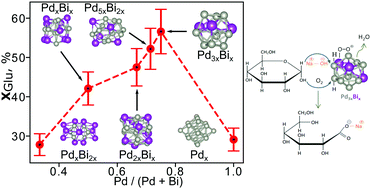Influence of the Pd : Bi ratio on Pd–Bi/Al2O3 catalysts: structure, surface and activity in glucose oxidation†
Abstract
Pd–Bi nanoparticles show high efficiency in catalyzing gluconic acid production by the glucose oxidation reaction. Although this type of catalyst was studied for some time, the correlation between bismuth content and catalytic activity is still unclear. Moreover, there is little information on the principles of the formation of Pd–Bi nanoparticles. In this work, the relation between bismuth content and the activity and selectivity of the PdxBiy/Al2O3 catalyst in the glucose oxidation process was studied. The catalytic samples were prepared by co-impregnation of the alumina support utilizing the metal–organic precursors of Pd and Bi. The samples obtained were tested in the glucose oxidation reaction and were studied by transmission electron microscopy (TEM), X-ray fluorescence analysis, X-ray photoelectron spectroscopy (XPS), and BET adsorption. It has been found that the Pd3 : Bi1 atomic ratio grants the highest catalytic efficiency for the studied samples. To explain this, we predicted stable Pd–Bi nanoparticles using ab initio evolutionary algorithm USPEX. The calculations demonstrate that nanoparticles tend to form Pd(core)–Bi(shell) structures turning to a crown-jewel morphology at lower Bi concentration, thus exposing the active Pd centers while maintaining the promoting effect of Bi.



 Please wait while we load your content...
Please wait while we load your content...